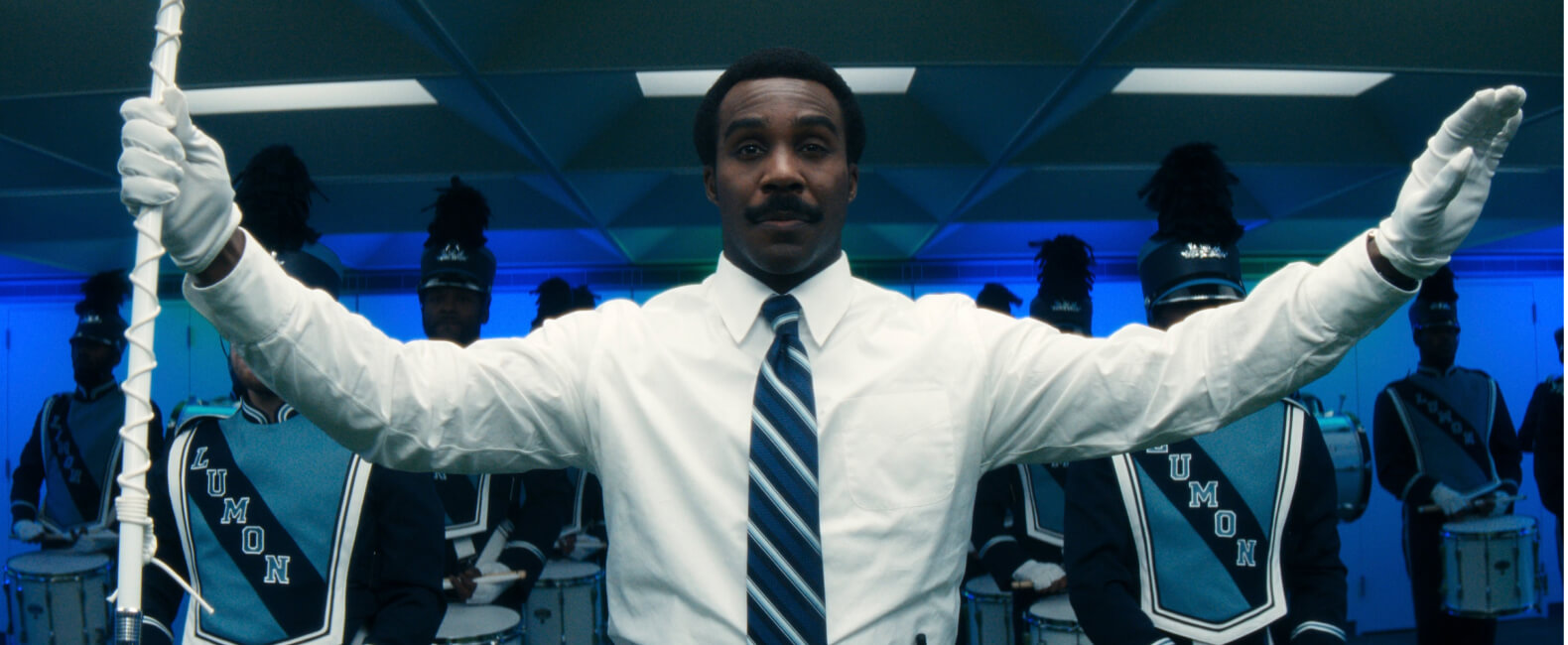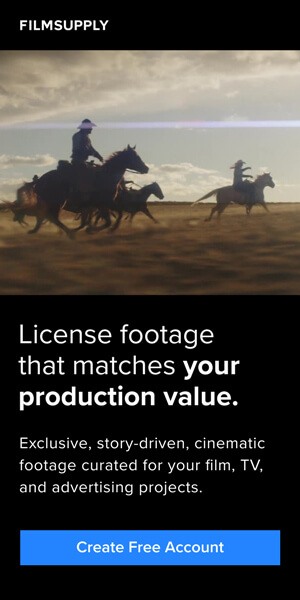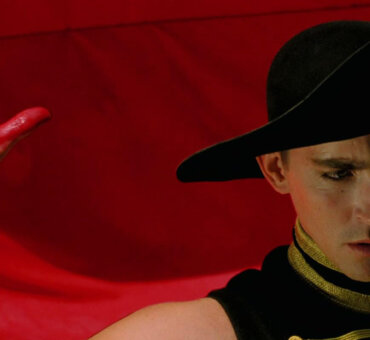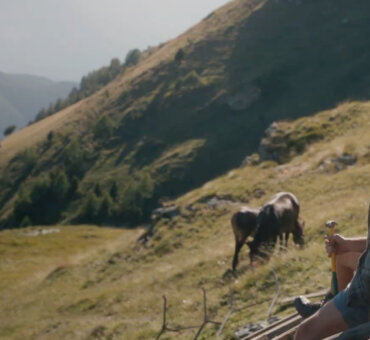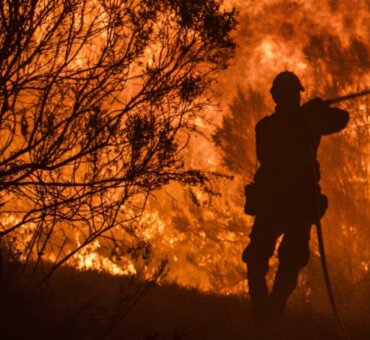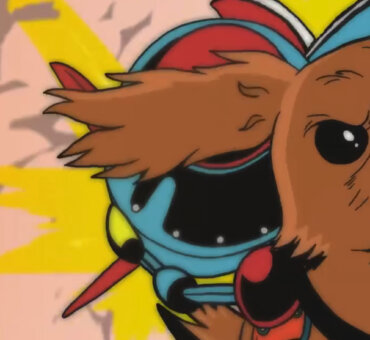Every great story starts with a script, but it’s in the edit bay where it truly comes to life. With the right footage and time to experiment, editors can elevate a good scene into a masterpiece.
The editing team behind AppleTV+’s hit show Severance is proof of this.
Hear from Severance editors Geoffrey Richman ACE, Joe Landauer, and Keith Fraase ACE. They discuss how a collaborative editing process allowed them to experiment, take chances, and ultimately craft a deeply emotional story.
Filmsupply: Going into season two, did you receive any notes about approaching the material? Right out of the gate, it seemed to gallop right along. But rather than running on all cylinders, there were effective pauses to the action with a number of pensive moments.
Geoffrey Richman ACE: We knew the direction of the story was going to go, so it wasn’t just a matter of accelerating things. It was expanding it outward into all these multiple innie and outie characters and their relationships.
Also, because we were able to move really fast, that sort of earned us the right to slow down.
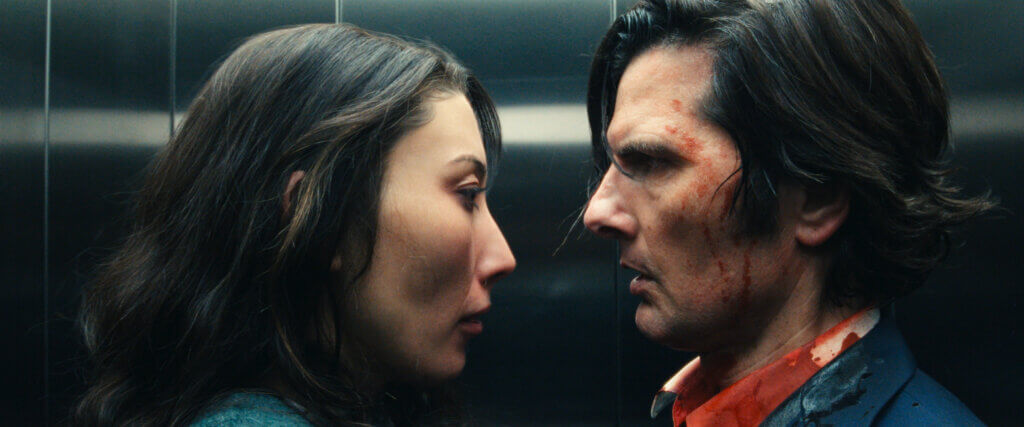
Joe Landauer: There was also a strong sense from the writers about what the endpoints for the season would be. Season one had the advantage of introducing this world to the audience. This incredible concept allowed for a lot of withholding of information, plus slow builds in terms of who’s who and who knows what.
By season two, you can’t confidently do that as much because the world is more clearly defined.
RELATED READS: Creating Immersive Worlds: Why “Chief of War” on AppleTV+ Used Filmsupply
Filmsupply: Certain series rely on mystery that functions like a puzzle box, where you’re unpeeling the onion. But with Severance, you’re not just peeling it back. It’s almost like the deeper you go, the wider the landscape, like you’re going anamorphic with your deep dive.
Joe Landauer: There’s a strict tonal control over the look and feel coming from the camera and from Ben [Stiller] and the other producers.
Those tonal controls and visual style of the film give us lots of editorial freedom because cutting within this landscape invites a lot of experimentation without feeling like you’re going to lose the thread.
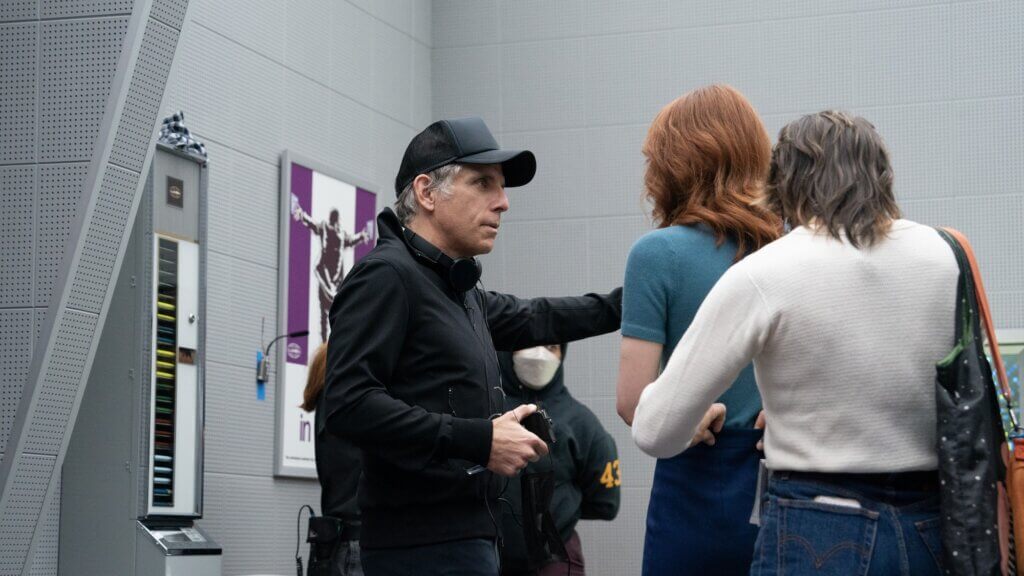
This visual consistency really helps us in editorial the same way our composer helps us musically: great resources allowing maximal choices, so we can build the scene as we see fit and still have freedom to adjust accordingly.
RELATED READS: 5 Things the Editing in “Severance” Can Teach Us About Storytelling
Keith Fraase ACE: Almost every setup is multicamera, so we get just tons and tons of footage.
We have the benefit of every choice we could make coming from a shot. Not just in terms of its compositional interest but also in its narrative interest.
And these shot choices are based on how to showcase character and emotion, what they’re going through.
I had the fortunate experience of working with lead DP Jessica Lee Gagne on the episode she directed. She had the visual language just so well thought through with Ben and the other directors, so what we get in editorial is a result of collaborative communication.
We’re also sharing ideas and talking about what Severance is and whether what we do represents that fully. Eventually, you develop that language where you internalize it and feel it.
Filmsupply: So you can feel confident about taking chances or spinning expectations?
Joe Landauer: There were choices allowing you to lean into the idea of Helly’s deception in episode one about what she experienced as an outie.
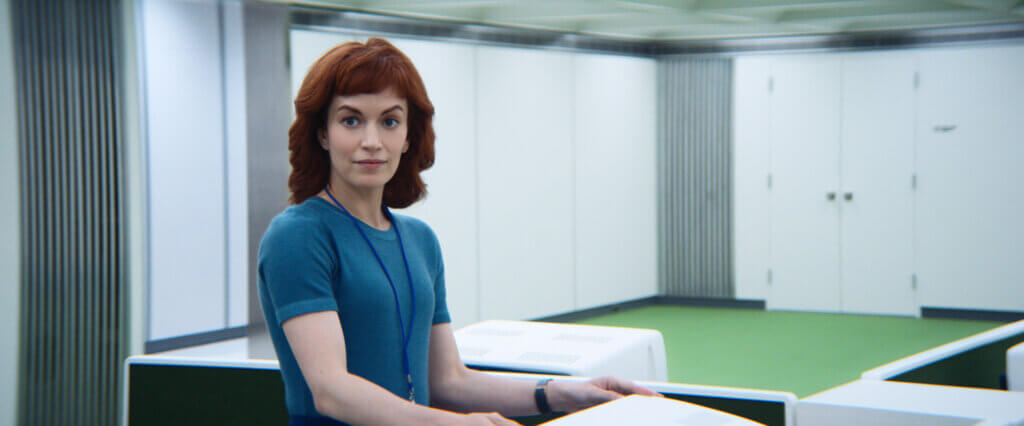
We could have made things more conspiratorial, because the visual language spoke to that. But you could also pull back and play it more typically so that you’re not pushing those levers too hard on the audience.
Geoff can speak to that …
Geoffrey Richman ACE: I did a fair amount of restructuring. It’s a testament to continuity and tone. There were so many times in the edit where we were giddily surprised.
There were new juxtapositions and associations between shots that could be created that were never even necessarily intended, because of this consistency in tone.
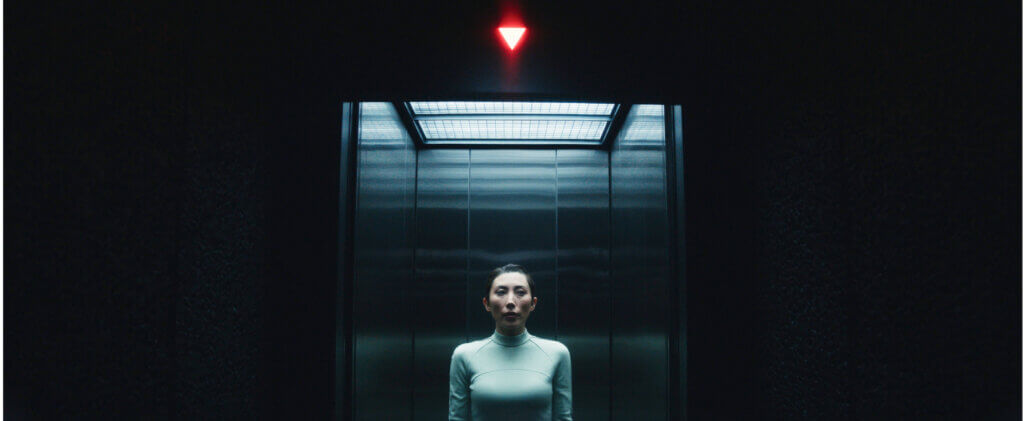
The shots tell the story. But we discovered in the edit that combining things in a certain way can create new feelings.
We could try dissolving into this shot or have a great effect added. But those choices wouldn’t have worked if you were limited by having standard dialog coverage.
It’s not just a question of whether we want to be close or wide. If you rely on more traditional coverage for too long, it can start to feel presentational. It makes it look like people are just delivering lines.
You have an option to go the other way, using more evocative coverage, to get away from what doesn’t work or engage.
RELATED READS: The Power of Unique POV Techniques in Commercial Filmmaking & Advertising
Joe Landauer: I can’t think of a time I was ever motivated to choose an angle just to invigorate. The story and the characters drove the edit, so I never really thought about how people would see it on television.
Keith Fraase ACE: The producers gave us a lot of time and space to experiment. They encouraged us to keep trying different things.
And so you think, Can I enter into the scene in a slightly different way? Let’s say Mark enters the scene in a slightly off-kilter emotional state: how can I find a different way in?
There’s that kind of friendly competitiveness between us that keeps making you want to keep working at the scene, never settling for too rote or simplistic. And having a reliable team that will call you on it if you push too far and go off the road, or encourage you to go further, that’s great.
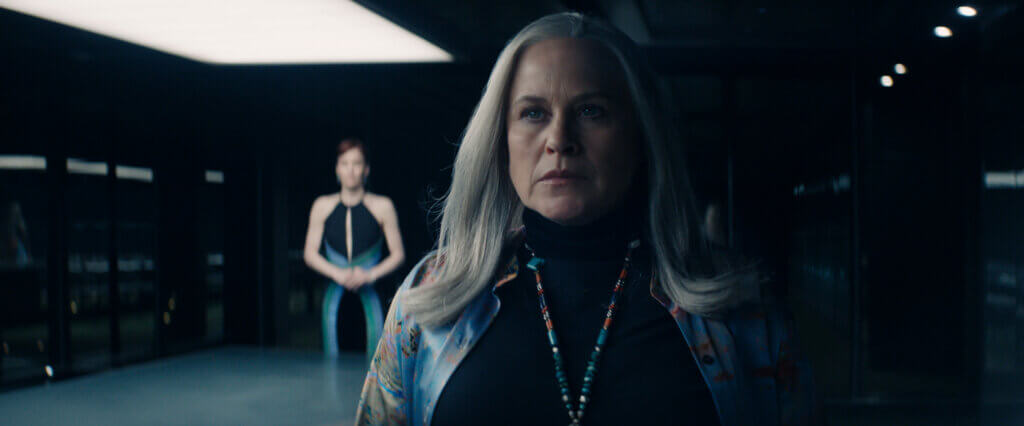
Joe Landauer: I think of the cross-cutting on the firing sequence in episode 2. When I first showed it to you guys, I was really thrilled with it. But when you watched it, Keith said, ‘you lost me on that motorcycle shot,’ and everyone agreed. I really had to go back and rethink it.
On a lot of television, it would have been at a very good cut, but there is always a way to make it better. This open dialogue felt more supportive than competitive.
We share our work, watch each other’s shows. Geoff was a real grounding force, having come from season one, and helped set the tone of the series.
Filmsupply: Keith mentioned coming in with an unusual way of starting a scene. What kinds of things might spark you?
I’ve gotta think having the colors you have available, like the office ceiling lights, would let you amplify things in ways other shows couldn’t.
Geoffrey Richman ACE: Red, blue, and green all express and evoke different things. And our part of our toolbox, along with these very rich performances, are amazing compositions and spectacular production design.
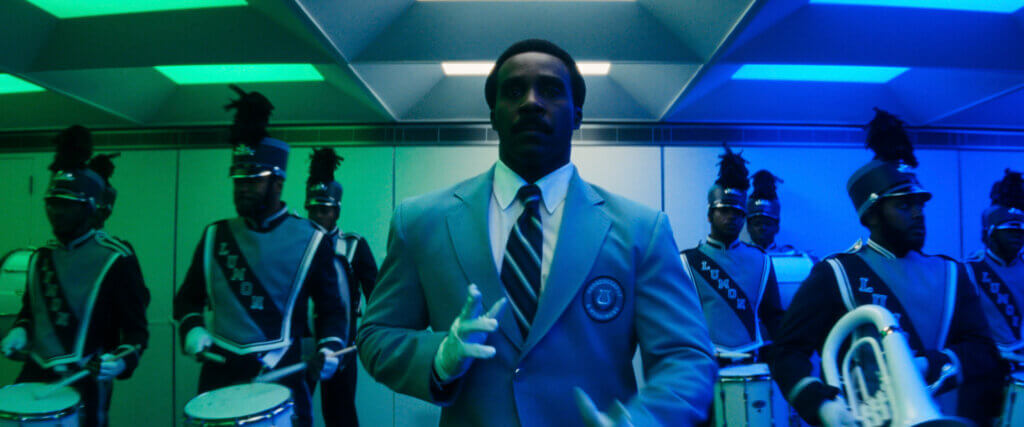
Working with a combination of those things create different feelings. If you play a particular feeling too long, just like in music, it loses its effect and actually can have a negative effect. Knowing when to step away and move on to a different idea makes sense.
Keith Fraase ACE: Episode 1’s opening run has a narrative thought behind it, in addition to being a cool shot. We would be sticking with Mark while he sprints through these hallways.
There’s a place of narrative propulsion that’s very important, especially for a show like this, where it could be easy to fall into being pretentious, or being mysterious for its own sake.
Intentionality is the core of all of this both on-set and in post.
RELATED READS: Drench Your Story in Color: Rich and Bold Palettes in Commercial Filmmaking
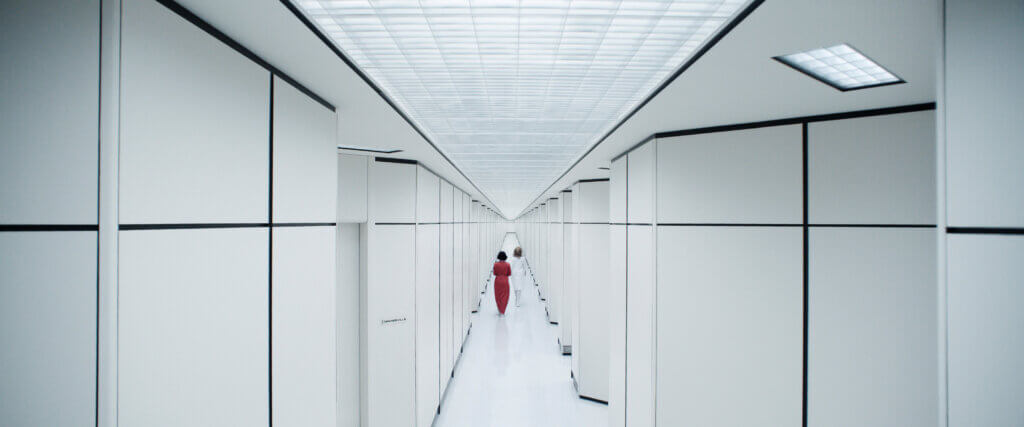
Filmsupply: With scenes in hallways, I was noticing that there’s sort of like a lot of soft cuts, quick dissolve type things with the camera moving into white as characters exit the shot.
But when characters do a walk and talk down the corridor, there’s more traditional cutting. Is there a conscious plan for how you choose to do transitions in that particular environment?
Geoffrey Richman ACE: A lot of connections, like dissolves between hallways, come out of us always trying to find ways to make each scene build off what went before, making connective tissue that goes beyond just assembly, to character and story. And so there’s an opportunity to feel an emotional connection.
But if that approach doesn’t work in the edit, we can go with more straightforward cuts.
Joseph Landauer ACE: We’re so blessed with a schedule that allows us the time to make these discoveries, which let us improve on things and find new structures.
You realize that certain aspects need more time to play out, because the episode starts speaking for you and to you.
Going in, you don’t know where those moments are going to be, though you might have a sense of it. But it evolved, and it is a process.
RELATED READS: Follow the Edit: Key Insights on Letting Your Project Lead the Way
Filmsupply: I can’t remember seeing a season-ending shot as satisfying as this season’s zoom freeze, which really calls back to a kind of ‘60s sensibility, like The Graduate and Hard Contract. It also relies on VFX with set extensions.
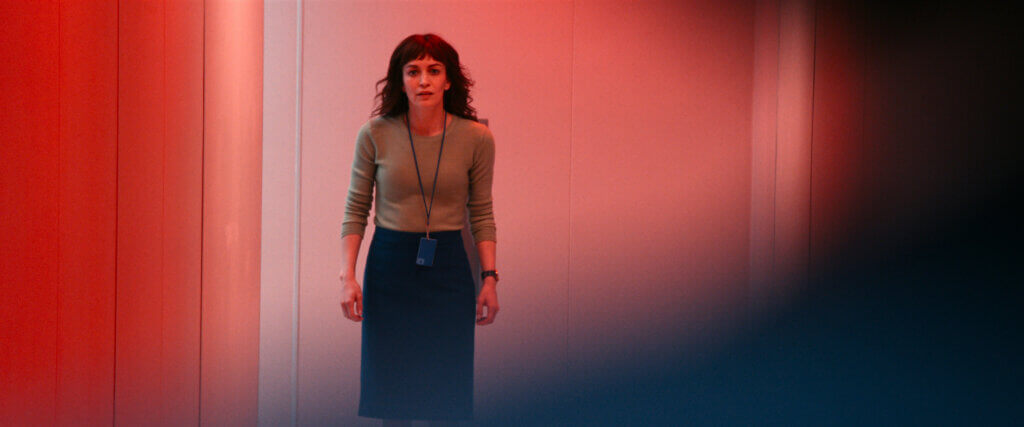
Geoffrey Richman ACE: Not every hallway had set extensions. But when we do, there’ll be a green screen.
Visual effects editor Matthew Huber is an amazing secret weapon on the team. He’s able to do temps very quickly.
And that makes it so we can have it in our edit before final VFX or even when vendors get their hands on it. So that let us very early in the process evaluate the whole shot without having to imagine around the greenscreens.
That last shot is a great example of how all these various things come together to create a feeling, such as color and movement, and you can’t put your finger on just where the feeling is coming from.
There’s the red color, the freeze frame, the facial expressions, and the camera moving in on them at the tail end. It all worked together to create a bigger feeling than you’d have gotten from any one of those parts.
The editing team behind Severance proves that a great edit is a conversation—a dialogue between story, footage, and the creative minds shaping it.
It’s a testament to what’s possible when you have the right tools, the time to experiment, and the freedom to find the story within the footage.
